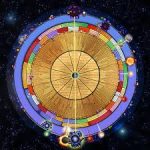All the planets move in their orbits around the Sun. Each moves at a different speed. They always move forward and astronomically there is no reverse or retrograde motion. However, when viewed from Earth, there is sometimes an apparent backward movement which is called retrogression or Vakri in astrology. Vakri could also be interpreted as crooked.

Do Planets Really Retrograde?
The favourite argument against astrology is that planets do not move backwards. However, the layman fails to understand what the birth chart really is. The birth chart of Kundali is nothing but a snapshot of the sky at the time of birth when viewed from the Earth. So the perspective is from the Earth and not from the Sun. Since the planets, each move at a different speed around the Sun, the apparent movement of each planet as seen from the Earth is different. This is because the Earth itself is moving around the Sun and so the point from which the planets are being viewed is not constant.
This is why sometimes planets ‘appear’ to be moving slower, faster and even backwards from the Earth’s perspective. What actually happens is that the planet is closer to the Earth than the Sun.

Retrograde Duration
All the planets have a period of time during which they are retrograde. Before the period of change from the normal forward motion to retrogression, there is a short period when the planet appears stationary. It is after this short stationary period that the planet starts retrogression. Similarly at the end of the retrograde period, the planet stations for a while and then goes direct again.
Saturn has approximately 5 days of stationing and 140 days of retrogression. Saturn is retrograde for about 36% of the time. Jupiter retrogrades for about 30% of the time and its retrograde is approximately 120 days long with 5 days of stationing. Mars is stationary for around 3 days and has a retrograde period of around 80 days. Venus stations of about 2 days and retrogrades for 42 days which is around 7% of the time. Mercury stations for only 1 day and retrogrades for 24 days which is about 19% of the time. So, we can see that with Saturn and Jupiter retrograde for 36% and 30% of the time, there are a lot of people who will have these planets retrograde in their charts. It is not as uncommon as one would presume.
Indicating Retrograde Planets In The Chart
When you look at a birth chart, there are different ways in which a retrograde planet may be indicated. Some systems underline the planet that is retrograde. Example: Ju. Others place the retrograde planet within brackets; example: (Ju). Other systems do not indicate anything on the chart diagram itself but instead in the list of planets place an R or Rx next to the planet. Example: Ju – R or Ju Rx
Interpreting A Retrograde Planet
The interpretation of a planet being retrograde is a topic where most astrologers have differing opinions. Some schools of astrology consider the retrograde planet to function in the opposite way to its significations. Others consider it to be a negative factor. Some consider the planet weak and others consider it to be strong.
Retrogression In The Classics
A study of classics such as the Bhrigu Sutram and Brihat Parashara Hora Shastra shows that retrogression was given more importance in calculating the Shadbala or strength of the planet more than the significations. When the placement of house lords as planets in signs and houses are discussed by the Sages, there is absolutely no mention of retrogression. Phaladeepika, however, suggests that when a debilitated planet is retrograde or in debilitated Navamsa, the planet gets strength when retrograde and the rays are brilliant.
Chesta Bala
The motional strength assigned to the planets differs depending on which part of the retrogression it is in. Retrogression within a Rashi is called Vakra. Retrogression into the previous sign is Anu Vakra or Athi Vakra. When the Speed is slow it is called Madhya Gati and the planet is called Manda. Decreasing slower than this is Mandatara and when it stations or stops it is Stambhi or Vikala. The strength assigned to Vakra, Anu Vakra, Vikala, Manda and Mandatara are 60, 30, 15, 15 and 7.3 respectively. The normal motion or Sama gets 30 points. So we can see that the Vakri motion of a planet gets the highest points.

The classic Saravalli states that the effects of retrogression depend on the nature of the planet. So planets that are benefics become more beneficial when retrograde and planets that are malefic become more malefic due to retrogression. This is interpreted that the innate nature of the planet becomes stronger. This is perhaps why the classics give a higher Chestabala (strength) to planets that are retrograde.
This strength of the planet is interpreted as it being very Karmic in nature. Because of the past Karma that has caused the retrogression of the planet in the birth chart, the Karma that the planet indicates is exceptionally strong. So, one can conclude that a birth chart with a retrograde planet indicates very strong Karma related to that planet.

Side Note – Mercury Retrograde
Western astrology reads retrogrades as the reversal of the indications of a planet. So, when Mercury which is closely linked with communication and travelling is retrograde it is thought that all matters related to communication and travel give unexpected results and problems. This is has become a part of popular culture regardless of whether a person believes in astrology or not.














